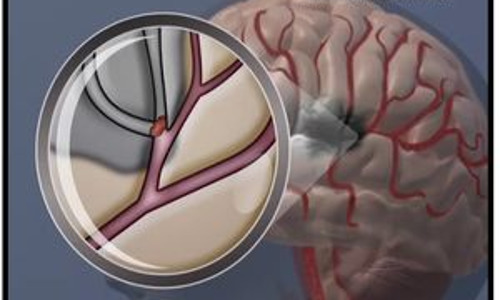
A team of neurosurgeons at Korea University Guro Hospital, Seoul, has described Middle Meningeal Artery Embolisation (MMAE) as an effective treatment alternative modality to surgery for refractory, recurrent and high-risk chronic subdural hematomas in volume reduction and improvement of clinical outcomes.
Chronic subdural hematoma (CSDH) is one of the most common neurosurgical diseases that primarily affects the elderly population, with an estimated incidence of 10/100,000. Surgical evacuation of hematoma, conducted using burr-hole trephination and drainage, is currently considered the gold standard for symptomatic CSDH. Elderly patients, who comprise the majority of CSDH patients, however, have a high risk of perioperative complications (up to 32%) for surgical intervention due to their old age and various comorbidities. The recurrence rate of surgical treatment, moreover, is reported as 10-30% at 1-8 week intervals. MMAE is a technique that has recently emerged as an alternative or adjunctive to surgical procedures.
CSDH presents as a severe headache, focal neurological lateralizing signs, or mental status change due to the mass effect. It occurs mainly in the elderly population because age-related brain atrophy renders cortical veins prone to shear injury and bleeding caused by minor head trauma. Over time, the hematoma develops pseudomembranes containing macrophages and giant capillaries that are connected to the termini of the middle meningeal arterioles. This vascularity is considered to be the main pathophysiology of hematoma expansion, mixed chronology of hematoma nature, and high recurrence rate after surgery. The mainstay of treatment for CSDH is surgery, conducted using burr-hole trephination. However, the recurrence rate after surgery is reportedly up to 30%. Elderly patients, who comprise the majority of the CSDH patient population, are at greater risk of surgical complications due to their comorbidities.
MMAE was introduced as an alternative to surgical treatment for CSDH to reduce perioperative complications for elderly patients at high risk. Considering the pathophysiology of CSDH, MMAE seems to block the connection between the giant capillaries of pseudomembranes and the MMA terminus of the dura. This blockage interrupts the blood supply to the pseudomembrane, prevents capillary rupture, reduces neoangiogenesis from the pseudomembrane, and eventually enhances the resolution of hematoma and resorption. This effect is believed to have reduced the recurrence rate. The hematoma volume reduction effect appeared to be initiated in the early postoperative stage.
The report, led by Jin Hoo Seok, retrospectively reviewed data prospectively collected from nine patients who underwent 13 MMAE using PVA particles for CSDH between June 2017 and May 2022 at their institute. The volume of the subdural hematoma was measured using a computer-aided volumetric analysis program. Hematoma volume changes during the follow-up period were analyzed and clinical outcomes were evaluated.
All procedures were technically successful and there were no procedure-related complications. They found that the average length of hospital stay after MMAE for all patients was 5.3 days. All patients’ clinical outcomes were favorable, showing improved modified Rankin Scale scores.
Volumetric analysis revealed a decrease of around 88% in the hematoma volume over time in all patients, indicating the effectiveness of MMAE for CSDH. 61.5% acquired complete hematoma resorption and they were not treated with subsequent surgery. Serial monthly image follow-ups demonstrated that early volume reduction occurred within 3 months in patients with complete resorption.
The authors suggest that MMAE chosen with narrow indications as a treatment modality for refractory, recurrent, or high-risk CSDH might be effective in hematoma volume reduction and improvement of clinical outcomes. They also propose conducting larger studies so that this technique can be initiated as a routine treatment alternative to burrhole surgery.
Reference: Jin Hoo Seok, Jong Hyun Kim, Taek Hyun Kwon, Joonho Byun, Won Ki Yoon Department of Neurosurgery, Korea University Guro Hospital, Seoul, Korea Middle meningeal artery embolization for chronic subdural hematoma in elderly patients at high risk of surgical treatment
Journal of Cerebrovascular and Endovascular Neurosurgery 2022;jcen.2022.E2022.08.003. DOI: https://doi.org/10.7461/jcen.2022.E2022.08.003
